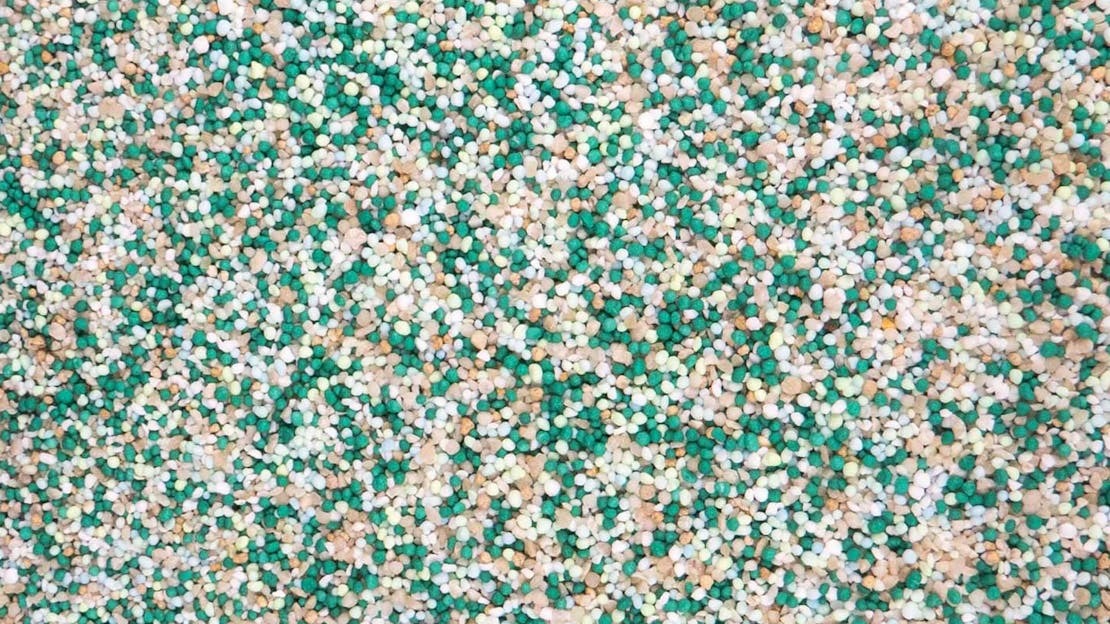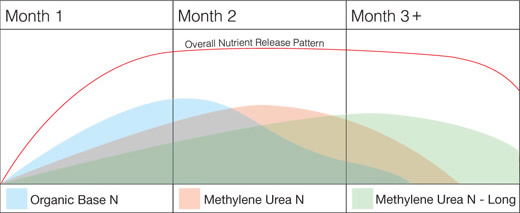
Slow Release Lawn Fertiliser
Using coated, soluble and slow release lawn fertiliser products can make the grass greener and lawn care maintenance and treatments a lot easier
Slow release fertiliser extends the time the fertiliser works on your grass; better for you and better for the lawn. The diagram below shows the multi-phase slow release pattern of the various components of the Spring & Summer Excel fertiliser.

Quick Release Fertiliser
The word ‘quick’ should really read ‘readily available’. In other words ‘quick release fertilisers’ have their nutrients in a form ready for use by the plant. They last between 4 and 6 weeks depending on temperature and moisture level.
The warmer and wetter it is the more fertiliser is required by the grass thus quickly reducing the amount remaining and therefore the time that the fertiliser will last. This means a surge in growth in ideal conditions and often the reason DIY fertilisers can cause mowing problems.
It may appear that quick release fertiliser is not a good thing. However, if used correctly it is of great help: fertilisers for low temperature use are often quick release as they may not work at all were they to be slow release.
In addition, when you apply fertiliser you usually want it to start working immediately but last for weeks or months. By combining quick release with slow release you can have immediate results over an extended period without excessive mowing or growth surges. All Lawnsmith slow release fertiliser has a portion of ‘quick release’ in it to give a quick albeit small lift to the grass so that it benefits immediately from the treatment. This is quite normal particularly if it is a spring or autumn fertiliser treatment.
Slow, Controlled or Extended Release Feeding
Slow release or controlled release fertiliser comes as a liquid, dry soil soluble granules or as coated non-soluble granules. All Lawnsmith® Granular Fertilisers except for STARTER and Winter Green are slow release with anything from 2 to 6 month longevity.
Soil Soluble Lawn Fertiliser
Soil soluble lawn fertiliser dissolves into the soil over a few days due to soil moisture; it is not meant to be dissolved by you in water prior to application. Some substances, such as iron sulphate for example do require dissolving prior to application.
The benefits of soluble lawn fertiliser are reduced risk of mower pick-up when using rotary mowers on close mown turf together with slightly improved movement of the nutrients away from the surface of the soil down to the roots. This may have some influence on deeper rooting as some fertiliser will go where the water is.
If this fertiliser is slow release it will have a chemical mechanism that prevents the nutrients being taken up by the plant all at once and will drip feed the grass over several months.
Coated Lawn Fertiliser
As the name suggests coated turf fertiliser products have a coating around the fertiliser granule or prill. The coating slows the release of the fertiliser nutrients; as the coating breaks down over time usually due to rising temperature the fertiliser is released. Therefore in cold weather when the grass doesn’t want to grow, very little fertiliser is released. On the other hand, as things warm up and the demand for fertiliser from the grass increases, more fertiliser is released.
The coating can be made of a variety of substances, quite commonly sulphur. This benefits the grass to a point as sulphur is a necessary plant nutrient and used to be abundant due to the smoke and acid rain caused by coal burning fires. Sulphur as it breaks down into its sulphate becomes acidic which is also beneficial for fine turf grasses whilst disadvantaging the weeds. However, over use of coated fertilisers can cause problems.
The great benefit of coated lawn fertiliser is that they will not wash away if there is extreme rainfall so are commonly used for the spring feed. The downside is they can be ‘sucked up’ by rotary mowers on close mown turf until they settle well into the turf. Leaving the box off for the first cut after fertilising the lawn is beneficial. Please check that your mower instructions allow this.